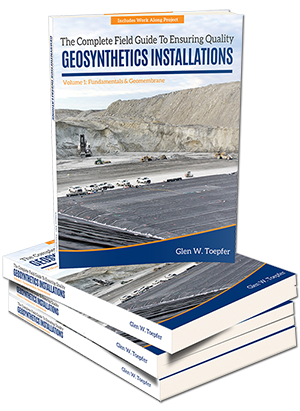Looks like there is a new wrinkle in wave management.
I finally had some free time to catch up on recent developments in the geosynthetics industry. One of the resources I use is the Geosynthetics Institute (GSI) website. During my search, I came across GSI White Paper #27, which focuses on intimate contact and wrinkle management. If you have not yet read this paper, I would encourage you to do so, as it offers new information as to what actually happens with wrinkles that are entombed by cover soil. For your convenience, here is the direct link to this article: http://www.geosynthetic-
I was surprised that some of the smaller wrinkles do not collapse, contrary to the popular belief that they would collapse and lie flat. My next thought was “Wow, this validates my CQA practices.” I have always pushed to minimize wrinkles and have tried to make various parties aware of the potential negative impacts of wrinkles, which are all listed in the article.
Last year, one of our senior CQA personnel was working on a landfill combination cap and separatory liner being constructed with LLDPE. A young regulatory person visited the site around lunch time, near the “heat of the day” and began complaining about all wrinkles (some as small as two inches) in the geomembrane. After seeing GSI White Paper #27 and noticing the date published was before this portion of our project, it suddenly made sense to me that this regulatory person probably read this article prior to this visit.
At the time of the project, our CQA tech tried to inform the regulatory agent that this was normal for this time of day, and that the wrinkles would be gone in the morning. None of the wrinkles were being covered. The agent apparently did not believe the CQA tech, installer, or owner and promptly issued a letter to the owner stating that the geomembrane needed to be reconstructed, due to wrinkles. I am sure you can imagine some of the phone calls and colorful dialogue. The letter was later overturned, and an apology issued by the regulatory agency.
We all “jump the gun” sometimes. To me, this experience was a reminder: When we consider all available information and make informed decisions, we can prevent needless and costly corrections.
As the article states, there is now new information that we need to take into consideration. However we need to also consider fluctuating temperatures and other variables in the field. What looks like a problem now may correct itself by the end of the day. The bottom line is that as the article points out, we need to take a closer look at wrinkles before and during final cover placement.
Finally, I wondered how this article would impact our industry. I received a piece of that answer on Friday (3/14/14) in an e-mail link from the Ohio Environmental Protection Agency (OEPA) regarding this exact subject. Here is a link to the OEPA Guidance Document pertaining to wrinkles: http://epa.ohio.gov/portals/
In reading through the OEPA Guidance Document, it is clear that there will be a renewed focus on wrinkles in the upcoming construction season, at least in Ohio. As owners, certifying engineers, installers, and fellow CQA personnel, I would like to hear your thoughts on wrinkles.
What guidelines and solutions do you use to maintain intimate contact? What are your thoughts on the OEPA Guidance Document? For those in Ohio, how do you see this OEPA Guidance Document impacting you? And, if there are any OEPA inspectors out there who would like to elaborate on the Guidance Document and what you are expecting to see upon a visit to the site (pertaining to wrinkles), I would welcome the opportunity to hear from you!



